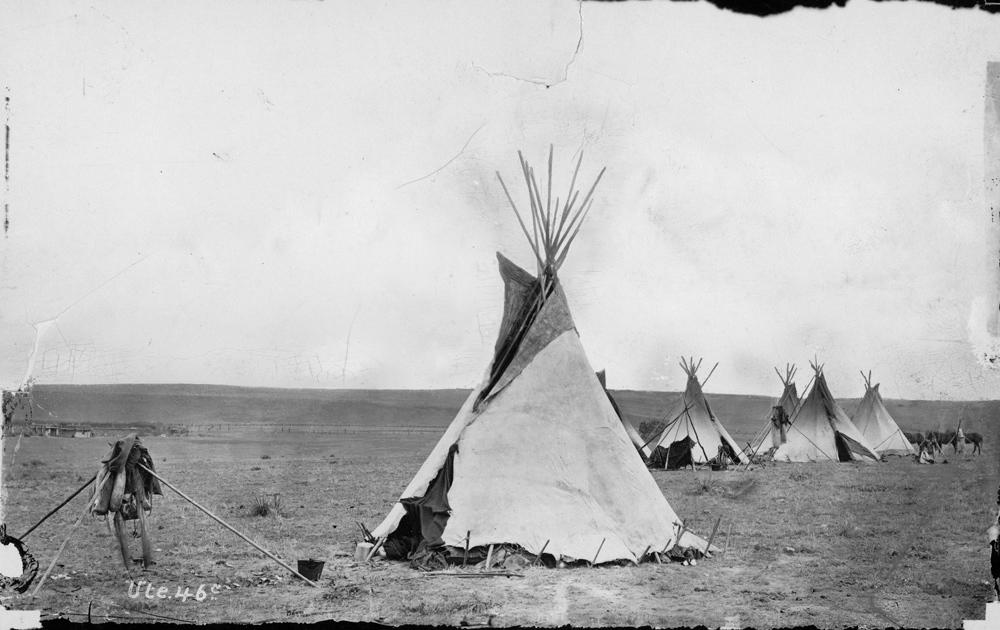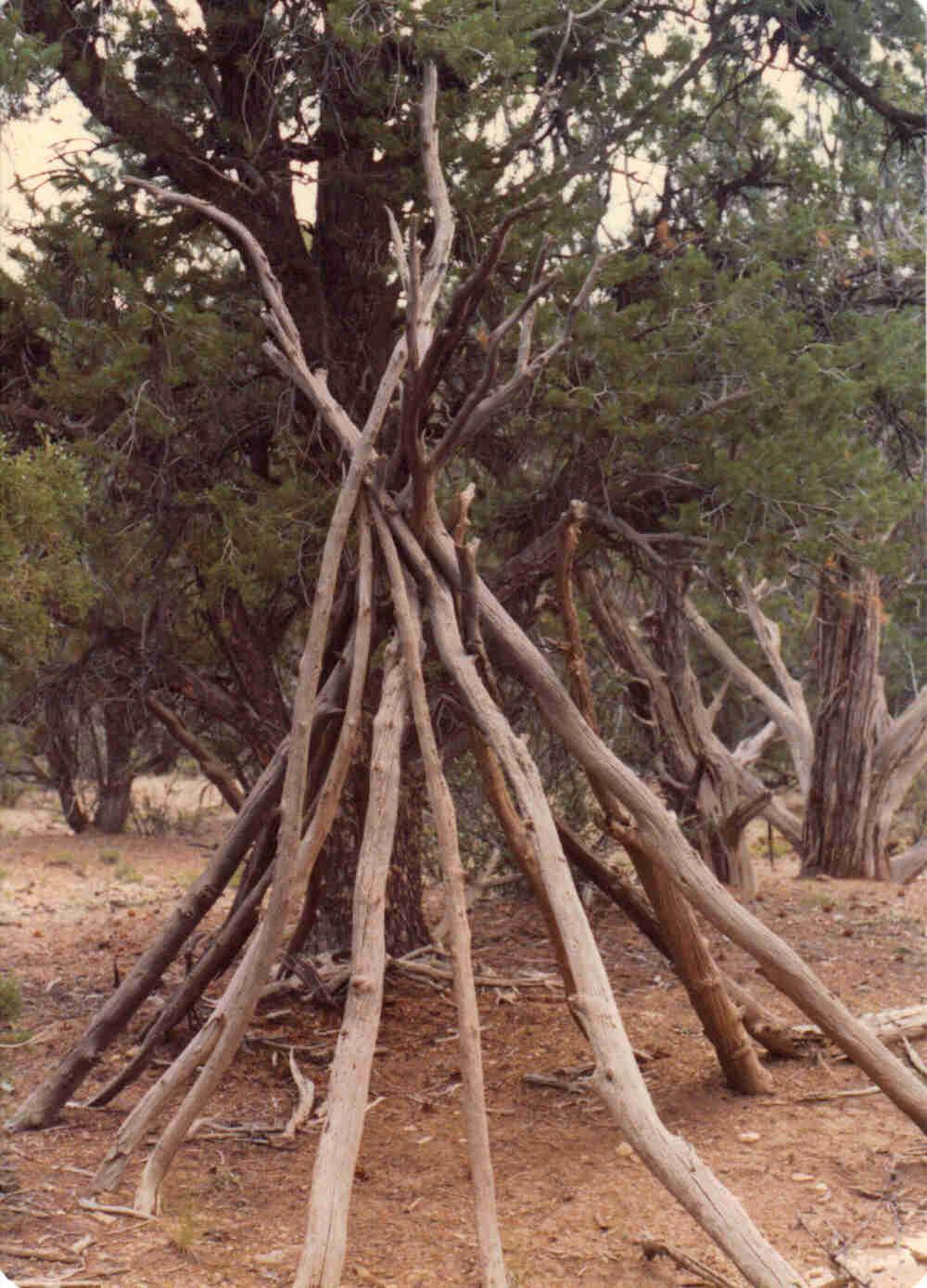Tipi
Full Article
The tipi, or tepee, is an iconic form of Native American housing. It has a long history of use throughout Colorado and the western plains of North America. Sturdy and secure yet portable, the hide-covered tipi has been an ideal shelter for millennia among mobile human groups. The term comes from Siouan languages as thipi or tīpī for dwelling or house, literally translated as “used to live in.”
Earliest Uses
The earliest evidence for the use of tipis in Colorado and adjacent states can be found in late Ice Age sites of the Paleo-Indian period. This evidence takes one of two forms: circular patterns of post molds—the organic imprints of rotted lodge poles—and spaced stone enclosures, or “tipi rings.” Standing pole frameworks from hide-covered lodges are rarely preserved, but a few examples remain in the old-growth forests of the Rocky Mountain region, most of which date from the mid-1800s to the early 1900s AD.
At the Hell Gap archaeological site in southeastern Wyoming, about ninety-five miles (155 km) north of the Colorado border, five separate post mold patterns are preserved in vertically stratified layers radiocarbon dated to the period 8800–10,450 BC. Four of these five features define lodges that are quite small, about six and a half feet in diameter; the fifth post mold pattern is about thirteen feet in diameter. While it cannot be proven whether or not these features represent the remains of hide-covered tipis as opposed to brush- or bark-covered wickiups, a conical or domed form to the superstructure best explains the arrangement and orientation of post molds. At the very least, these are among the oldest known lodges in the west.
The Hell Gap site also preserves the most ancient stone tipi ring feature known to science in this region. A single oval-shaped, spaced stone enclosure about seven and a half feet in diameter is buried in a late Paleo-Indian layer radiocarbon dated to slightly younger Paleo-Indian times at about 7800 BC. Such rings of usually flat stone slabs were used to anchor the perimeter of the hide covering on the lodge. In later eras, these features become the most common evidence of housing in grassland environments from southern Canada to Texas, numbering in the hundreds of thousands. Where stone was not naturally available, wood or bone pegs were used to fix the base of the hide covering through attached loops, but these stakes are almost never preserved. Their use is best documented in historical photographs.
Stone tipi rings are found in sites throughout Colorado, but are much more numerous on the western plains beginning in the Archaic period after 6500 BC. Even during the Formative period, when some native tribes had adapted a farming lifestyle based on cultivation of corn with some beans and squash, the tipi continued to be used as a temporary lodge for hunting and gathering excursions. Tipi rings of later periods are generally 10–20 feet in diameter, defining a floor area of about 75–300 square feet. Once horses spread among Native American groups in the seventeenth and eighteenth centuries, the “modern” tipi form developed as an often larger, taller structure housing a single nuclear family with one or a few relatives such as a single parent.
To be sure, some Colorado groups maintained their traditional nomadic lifestyle throughout the Prehistoric era into documented history, with the tipi as a favored choice of shelter. By the gold rush of the mid-nineteenth century, historical accounts in newspapers, photographs, and other records document the use of the tipi by virtually every indigenous group that inhabited Colorado.
Architectural Details
From afar, tipis display a very symmetrical form, but on closer inspection, their actual “tilted cone” shape comes into view. Steepest in the rear, the tipi wall slopes more gradually on the front side toward the doorway, an angle emphasized by the smoke flaps at the top of the lodge that are held forward by long exterior poles. Construction of the lodge begins with a framework of three or four poles upon which the remaining interior posts rest. The tripod frame is most common among the Arapaho, Cheyenne, Kiowa, Lakota Sioux, and Pawnee. The doorway often faces east to the rising sun, and is no more than a gap in the hide covers that can be secured with bone or wood pins.
Up to eight prepared bison hides (or skins of other large game) were needed to cover a single tipi ten feet in diameter. Historical photographs and the occasional rock art panel show that exterior surfaces were often brightly painted with scenes featuring animals, people, spirit beings, or other symbols. In the nineteenth century, canvas covers quickly replaced hides as the bison herds dwindled from hunting pressure and, especially, wholesale slaughter by US government sanction. Canvas has the added benefit of being more lightweight and thus easier to transport.
Fireplaces are located a bit off-center in a floor pit, or may be placed outside the lodge in warmer months. Sleeping space is arranged around the lodge wall, and may be segregated by gender, as was also true of sitting space. Storage of small articles likewise is around the edges, between the beds. For example, in a Sioux or Kiowa tipi the men generally sit on the north side and the women on the south side of the floor space. In a larger lodge or in tipis of ceremonial function, more central floor space may also be reserved for special activities, the specifics of which vary by tribal affiliation.
Tipi Camps
Both historically and in earlier times, the size of tipi encampments varied significantly. Prehistoric tipi ring sites in Colorado may have only a single-lodge foundation preserved, but sites with five to twenty rings are not uncommon. However, the original number of lodges present can be difficult to discern if stone slabs were collected and reused in a nearby location or redistributed on-site for other purposes. Camps containing scores or hundreds of lodges also occur on the western plains of North America, and even larger camps of more than a thousand lodges were documented—Custer’s men attacked a village of about 1,200 lodges at Little Bighorn.
The spatial pattern of lodges within a camp also varied by tribe. In certain circumstances, lodges were arranged in a circular pattern with an opening on the east side of the camp, mirroring the design of an individual lodge. This “camp circle” has been documented among many plains tribes, but not for the Comanche. The camp circle exemplified group cohesion, and was mandated for formal events such as ceremonial occasions and communal hunting forays. In other cases, a seemingly random scatter of lodges may have obscured a subtler pattern of slight clustering among a subset of lodges housing members of an individual clan or other social or kinship grouping. Regardless of the lodge pattern, individual families and bands within a tribe would recognize where they belonged within the village layout.
While habitation is the most common function recognized for tipis, many other non-domestic activities took place in lodges reserved for special purposes. Larger tipis within a camp may mark the lodge of a village chief, and also could be marked with a banner of some kind tied to the top of the tallest lodge post—the “lifting pole” at the rear to which the covering is tied. Smaller tipis might be built by children, who may erect even smaller lodges for their dogs. Warrior societies within tribes such as the Cheyenne and Lakota Sioux may have a lodge reserved for their activities, just as a “medicine lodge” can house the village shaman. An especially large “council house” accommodates group events, and some tribes built burial tipis after the passing of important individuals, necessitating that the camp be moved.
Past and Future
In the mountains and Western Slope of Colorado, the traditional Ute Indian lodge was a smaller wickiup either freestanding, like a tipi, or a lean-to built against a large tree. However, by the seventeenth century, the Utes had acquired horses from the Spanish to the south and began making more frequent forays onto the plains. There they hunted bison and adapted a number of practices from their neighbors, including, given their newfound access to abundant bison products, the larger hide-covered tipi. Theirs was a four-pole-framed tipi, a design similar to that of their northern cousins, the Eastern Shoshone.
Tipis remain an exemplary form of traditional architecture, emblematic of the nomadic lifeways of so many Plains Indian tribes in North America. Modern Anglo-Americans in particular appear drawn to them as significant and symbolic features of Native American histories seemingly lost to time.
However, the tipi endures today as both a sacred tie to tradition among Indian tribes and as a highly functional form of shelter for others engaged in everything from recreation to “back-to-nature” rural living. Its circular form is symbolic of the cycle of life, just as its traditional construction materials come from the land and cycle back into it upon abandonment. Given all of its advantages, combining simplicity of design with extreme functionality, the tipi’s endurance as an option for shelter seems assured.





















